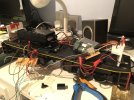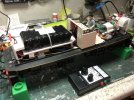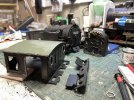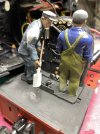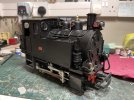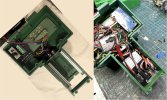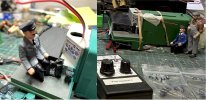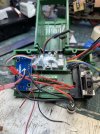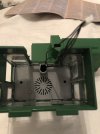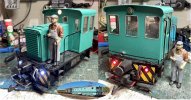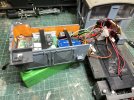viaEstrecha
Spanish metre gauge in G scale (on the cheap)
Forgive the self-indulgence, creating a thread to show off my lack of talent! That said, maybe someone wishing to do something similar might learn from my experience.
A visit to the DunnyBahn last year, to assist working a day's timetable, convinced me that my own garden railway needed to move from track power to battery and radio control, to enhance the operating potential and save my knees, getting down to clean the track. I had always wanted to go beyond basic DC analogue one day, though DCC looked too complicated and expensive. Having the chance to experience hands-on, RC operation with batteries, made the conversion option much less intimidating.
That said, it was not an easy decision. The averaged cost of conversion was about the same again as I had paid for each loco, and was effectively written off immediately, as my bodging would do nothing to add to the residual worth. But hey - it's my principal hobby after all.
Fortunately an opportunity arose to embark on the project with the encashment of a very small and almost forgotten pension. I liked (and almost understood) the Fosworks kit John showed me, and it made sense to standardise components and design for the whole fleet. I took the plunge and orders were placed. It helps too, that Steve Foster is approachable and generous with advice to newbies.
This thread will provide an account of how I get on, as there are ultimately at least ten motorised models to convert for my fictional line with a Spanish theme, and I've never before attempted anything like it.
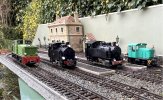
To mark the half way point in the project, four of the first phase conversions pose at a wintry El Boixar station
I go for cheap low-end models, secondhand mostly, and as I undertook the conversions, I've also been attempting differing levels of makeover, to give them a vaguely Spanish appearance, though I never model actual prototypes. I'm also slow and have low standards, which helps!
To begin, I needed to obtain the basic common bits of kit required to support a mass conversion. The initial investment included a pair of Fosworks Omni Tx4.10R handsets, which can flit between any of the 10 locos, with up to 12 functions plus forward/reverse speed control. All but one of my fleet is simple out of the box analogue and so I use mostly the first 6 sound functions, but I have one token clever machine already equipped for DCC and with a fancy sound card and so I required the handsets to cope with that too. I also shelled out on a Fosworks remote handset, to allow re-programming of the sound in an installed loco, as Dra Estrecha objected to my pinching the bedroom TV remote.
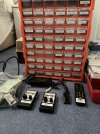
In addition to the necessary common support components, as a retired logistician, I was more or less obliged to invest also in a smart new 'small parts store' for my electronics bits. I assemble all the parts and accessories required for each loco in a bag with a checklist - a useful discipline when sourcing widely over several weeks.
Lithium horror stories influenced my decision to standardise on old fashioned NiMH batteries (Fosworks also supplies custom battery packs so I didn't need to learn that skill) and I need just one charger and battery state monitor for the whole fleet. My line is fairly small, speeds are low and I have a short attention span when operating and so I don't need huge battery capacity to run all day. I followed advice to photograph mocked-up packs using old batteries to send the design to be made up.
The only other requirements I wanted were that each loco should have sound (I have understanding neighbours for now, at least) and lighting should not flicker at low speed and stay on when the locos are stationary. My railway, my rules.
Dunnyrail kindly demonstrated the first conversion on a loco I bought from him and then it was back to the bench at home for several months of fun and games as I have been attempting to do the others myself.
I also copied John by creating a database with details of what I was doing to each loco and including a record of use and charging for each battery pack.
The next posts in this thread will document each loco in turn and will appear periodically. The easily bored and those of a nervous disposition should look away now and return to the Coffee Lounge.
A visit to the DunnyBahn last year, to assist working a day's timetable, convinced me that my own garden railway needed to move from track power to battery and radio control, to enhance the operating potential and save my knees, getting down to clean the track. I had always wanted to go beyond basic DC analogue one day, though DCC looked too complicated and expensive. Having the chance to experience hands-on, RC operation with batteries, made the conversion option much less intimidating.
That said, it was not an easy decision. The averaged cost of conversion was about the same again as I had paid for each loco, and was effectively written off immediately, as my bodging would do nothing to add to the residual worth. But hey - it's my principal hobby after all.
Fortunately an opportunity arose to embark on the project with the encashment of a very small and almost forgotten pension. I liked (and almost understood) the Fosworks kit John showed me, and it made sense to standardise components and design for the whole fleet. I took the plunge and orders were placed. It helps too, that Steve Foster is approachable and generous with advice to newbies.
This thread will provide an account of how I get on, as there are ultimately at least ten motorised models to convert for my fictional line with a Spanish theme, and I've never before attempted anything like it.

To mark the half way point in the project, four of the first phase conversions pose at a wintry El Boixar station
I go for cheap low-end models, secondhand mostly, and as I undertook the conversions, I've also been attempting differing levels of makeover, to give them a vaguely Spanish appearance, though I never model actual prototypes. I'm also slow and have low standards, which helps!
To begin, I needed to obtain the basic common bits of kit required to support a mass conversion. The initial investment included a pair of Fosworks Omni Tx4.10R handsets, which can flit between any of the 10 locos, with up to 12 functions plus forward/reverse speed control. All but one of my fleet is simple out of the box analogue and so I use mostly the first 6 sound functions, but I have one token clever machine already equipped for DCC and with a fancy sound card and so I required the handsets to cope with that too. I also shelled out on a Fosworks remote handset, to allow re-programming of the sound in an installed loco, as Dra Estrecha objected to my pinching the bedroom TV remote.

In addition to the necessary common support components, as a retired logistician, I was more or less obliged to invest also in a smart new 'small parts store' for my electronics bits. I assemble all the parts and accessories required for each loco in a bag with a checklist - a useful discipline when sourcing widely over several weeks.
Lithium horror stories influenced my decision to standardise on old fashioned NiMH batteries (Fosworks also supplies custom battery packs so I didn't need to learn that skill) and I need just one charger and battery state monitor for the whole fleet. My line is fairly small, speeds are low and I have a short attention span when operating and so I don't need huge battery capacity to run all day. I followed advice to photograph mocked-up packs using old batteries to send the design to be made up.
The only other requirements I wanted were that each loco should have sound (I have understanding neighbours for now, at least) and lighting should not flicker at low speed and stay on when the locos are stationary. My railway, my rules.
Dunnyrail kindly demonstrated the first conversion on a loco I bought from him and then it was back to the bench at home for several months of fun and games as I have been attempting to do the others myself.
I also copied John by creating a database with details of what I was doing to each loco and including a record of use and charging for each battery pack.
The next posts in this thread will document each loco in turn and will appear periodically. The easily bored and those of a nervous disposition should look away now and return to the Coffee Lounge.

